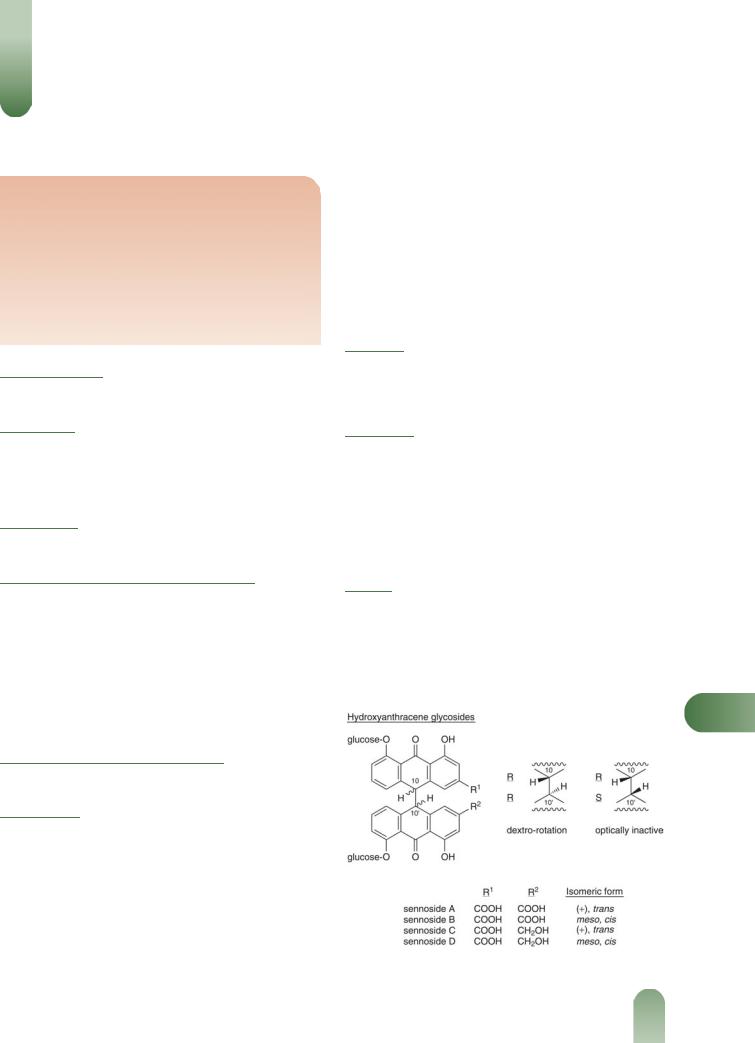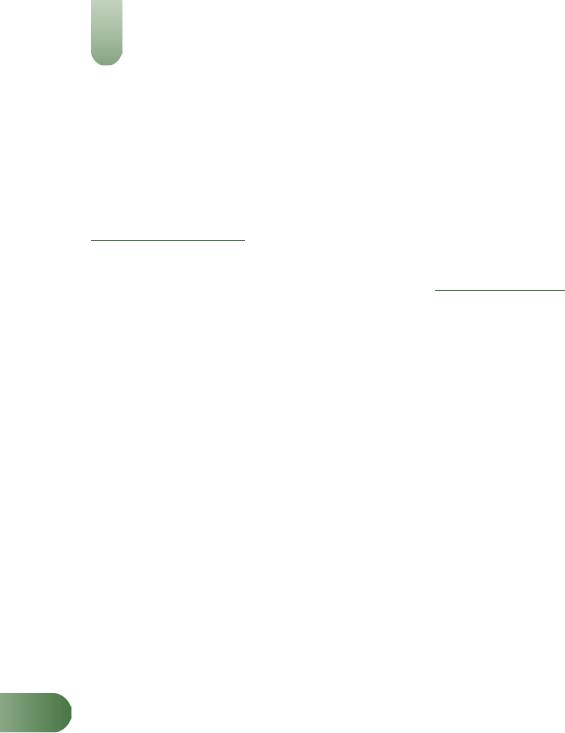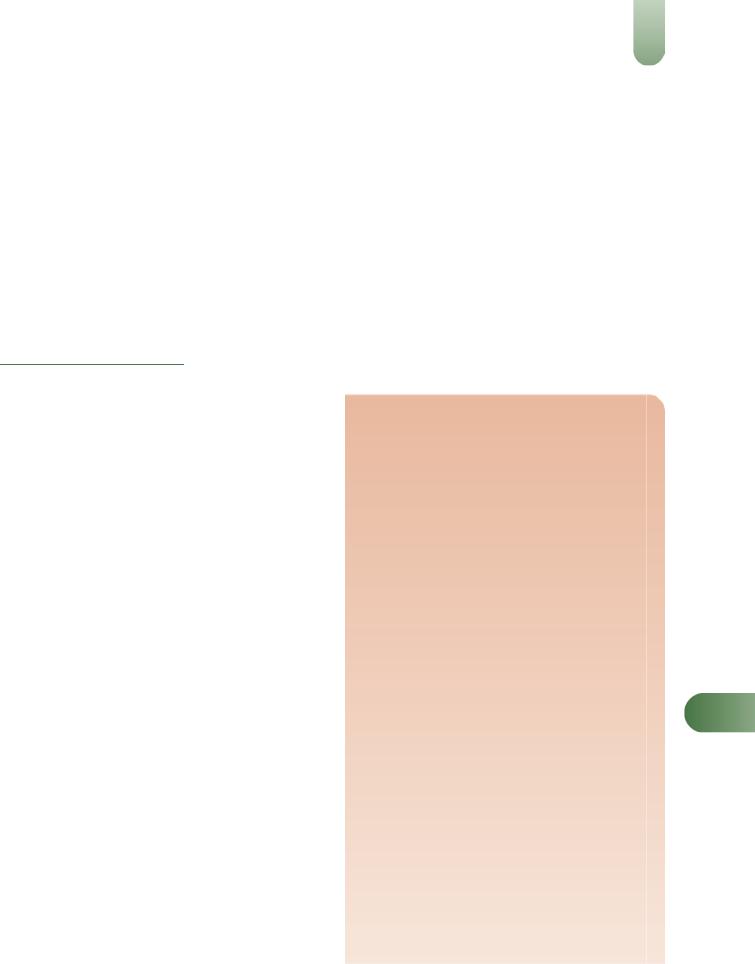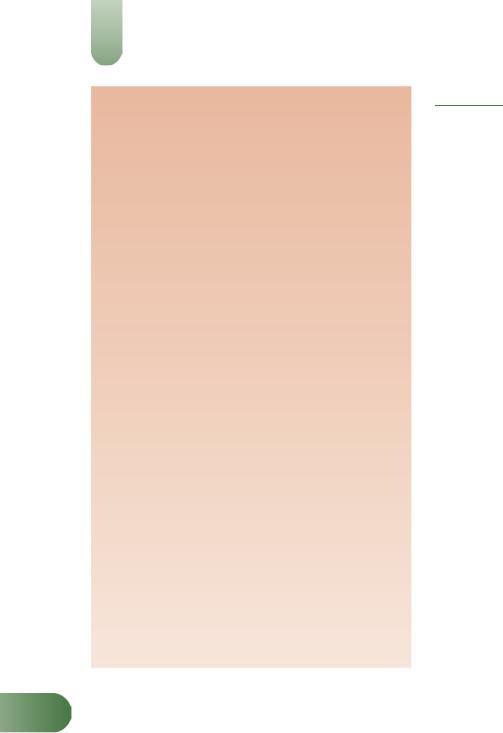
- •Contents
- •Preface to the Third Edition
- •About the Authors
- •How to Use Herbal Medicines
- •Introduction
- •General References
- •Agnus Castus
- •Agrimony
- •Alfalfa
- •Aloe Vera
- •Aloes
- •Angelica
- •Aniseed
- •Apricot
- •Arnica
- •Artichoke
- •Asafoetida
- •Avens
- •Bayberry
- •Bilberry
- •Bloodroot
- •Blue Flag
- •Bogbean
- •Boldo
- •Boneset
- •Borage
- •Broom
- •Buchu
- •Burdock
- •Burnet
- •Butterbur
- •Calamus
- •Calendula
- •Capsicum
- •Cascara
- •Cassia
- •Cat’s Claw
- •Celandine, Greater
- •Celery
- •Centaury
- •Cereus
- •Chamomile, German
- •Chamomile, Roman
- •Chaparral
- •Cinnamon
- •Clivers
- •Clove
- •Cohosh, Black
- •Cohosh, Blue
- •Cola
- •Coltsfoot
- •Comfrey
- •Corn Silk
- •Couchgrass
- •Cowslip
- •Cranberry
- •Damiana
- •Dandelion
- •Devil’s Claw
- •Drosera
- •Echinacea
- •Elder
- •Elecampane
- •Ephedra
- •Eucalyptus
- •Euphorbia
- •Evening Primrose
- •Eyebright
- •False Unicorn
- •Fenugreek
- •Feverfew
- •Figwort
- •Frangula
- •Fucus
- •Fumitory
- •Garlic
- •Gentian
- •Ginger
- •Ginkgo
- •Ginseng, Eleutherococcus
- •Ginseng, Panax
- •Golden Seal
- •Gravel Root
- •Ground Ivy
- •Guaiacum
- •Hawthorn
- •Holy Thistle
- •Hops
- •Horehound, Black
- •Horehound, White
- •Horse-chestnut
- •Horseradish
- •Hydrangea
- •Hydrocotyle
- •Ispaghula
- •Jamaica Dogwood
- •Java Tea
- •Juniper
- •Kava
- •Lady’s Slipper
- •Lemon Verbena
- •Liferoot
- •Lime Flower
- •Liquorice
- •Lobelia
- •Marshmallow
- •Meadowsweet
- •Melissa
- •Milk Thistle
- •Mistletoe
- •Motherwort
- •Myrrh
- •Nettle
- •Parsley
- •Parsley Piert
- •Passionflower
- •Pennyroyal
- •Pilewort
- •Plantain
- •Pleurisy Root
- •Pokeroot
- •Poplar
- •Prickly Ash, Northern
- •Prickly Ash, Southern
- •Pulsatilla
- •Quassia
- •Queen’s Delight
- •Raspberry
- •Red Clover
- •Rhodiola
- •Rhubarb
- •Rosemary
- •Sage
- •Sarsaparilla
- •Sassafras
- •Saw Palmetto
- •Scullcap
- •Senega
- •Senna
- •Shepherd’s Purse
- •Skunk Cabbage
- •Slippery Elm
- •Squill
- •St John’s Wort
- •Stone Root
- •Tansy
- •Thyme
- •Uva-Ursi
- •Valerian
- •Vervain
- •Wild Carrot
- •Wild Lettuce
- •Willow
- •Witch Hazel
- •Yarrow
- •Yellow Dock
- •Yucca
- •1 Potential Drug–Herb Interactions
- •4 Preparations Directory
- •5 Suppliers Directory
- •Index

Senna
Summary and Pharmaceutical Comment
The chemistry of senna is characterised by the hydroxyanthracene derivatives. The laxative action of these compounds is well recognised and supports the herbal use of senna as a laxative for the treatment of constipation. However, the use of non-standardised hydroxyanthracenecontaining preparations should be avoided since their pharmacological effect will be variable and unpredictable. The sennoside content of many licensed senna products is standardised and generally calculated as sennoside B. The use of senna during pregnancy and lactation should be avoided.
Species (Family)
Senna alexandrina Mill. (Leguminosae)
Synonym(s)
Alexandrian Senna, Cassia acutifolia Delile, C. angustifolia M. Vahl, C. alexandrina (Garsault) Thell., C. senna L., Indian Senna, Khartoum Senna, Senna acutifolia (Delile) Batka, S. alexandrina Garsault, S. angustifolia (Vahl) Batka, Tinnevelly Senna
Part(s) Used
Fruit (pod), leaf
Pharmacopoeial and Other Monographs
BHC 1992(G6)
BHP 1996(G9)
BP 2007(G84)
Complete German Commission E(G3)
EMEA HMPC Community Herbal Monograph(1) ESCOP 2003(G76)
Martindale 35th edition(G85) Ph Eur 2007(G81) USP29/NF24(G86)
WHO volume 1 1999(G63)
Legal Category (Licensed Products)
GSL(G37)
Constituents
The following is compiled from several sources, including General References G2,G6, G7, G20 and G52.
Hydroxyanthracenes Pharmacopoeial standards not less than 2.5% for leaf and 2.2% for C. angustifolia fruit.(G81, G84)
Dianthrone glycosides (1.5–3% leaf; 2–5% fruit), primarily sennosides A and B (rhein dianthrones) with sennosides C and D (rhein aloe-emodin heterodianthrones), aloe-emodin dianthrone. Sennosides A and B yield sennidin A and B respectively. Free anthraquinones including aloe-emodin, chrysophanol and rhein with their glycosides.
Carbohydrates Polysaccharides (about 2.5%)(2) including mucilage (arabinose, galactose, galacturonic acid, rhamnose) and a galactomannan (galactose, mannose);(3) free sugars (e.g. fructose, glucose, pinitol, sucrose).
Flavonoids Flavonols, including isorhamnetin and kaempferol.
Glycosides 6-Hydroxymusizin and tinnevellin glycosides.
Other constituents Chrysophanic acid, salicylic acid, saponin, resin, volatile oil (trace).
Food Use
Senna is listed by the Council of Europe as a natural source of food flavouring. Previously, senna has been listed as GRAS (Generally Recognised As Safe).
Herbal Use
Senna is stated to possess cathartic properties (leaf greater than fruit) and has been used traditionally for constipation.
The German Commission E approved use for constipation.(G3) Senna is also used in combination with ispaghula for constipation.(G3) The EMEA Committee on Herbal Medicinal Products (HMPC) has adopted community herbal monographs for senna leaf and senna fruit with indications for short-term use in cases of occasional constipation.(3)
Dosage
Dosages for oral administration (adults) for traditional uses recommended in older and contemporary standard herbal and pharmaceutical reference texts are given below.
Dried pods 3–6 pods (Alexandrian) or 4–12 pods (Tinnevelly) steeped in 150 mL warm water for 6–12 hours;(G6, G7) 0.6–0.2 g
(equivalent to 20–30 mg hydroxyanthracene glycosides calculated as sennosides B).(G52)
S
Figure 1 Selected constituents of senna.
537

538 Senna
Dried leaflets 0.5–2.0 g(G6, G7) (equivalent to 20–30 mg hydroxyanthracene glycosides calculated as sennoside B).(G52)
Leaf, liquid extract 0.5–2.0 mL (1 : 1 in 25% alcohol).(G6, G7)
Senna Liquid Extract (BPC 1973) 0.5–2.0 mL.
Herbal drug preparations Equivalent to 15–30 mg hydroxy-
anthracene derivatives (calculated as sennoside B) to be taken at night.(1)
Pharmacological Actions
The cathartic action of hydroxyanthracene-containing drugs is well recognised and such preparations have been used as laxatives for many years. However, there is still some uncertainty as to the exact mode of action of the hydroxyanthracenes. It is thought that hydroxyanthracene glycosides are absorbed from the gastrointestinal tract, the aglycones liberated during metabolism and excreted into the colon resulting in stimulation and an increase in peristalsis. However, it has also been suggested that the purgative action of senna is due to the action of intestinal bacteria.(4) Using human intestinal flora, it was found that sennoside A is reduced to 8-glucosyl rheinanthrone, hydrolysed to rheinanthrone and oxidised to sennidin A. The active principle causing peristaltic movements of the large intestine was thought to be rheinanthrone.(4)
In vitro and animal studies
Sennosides A and B, and their natural metabolites sennidins A and B, have been reported to act specifically on the large intestine in the rat with the acceleration of colonic transport the major component of their laxative effect.(5) Sennosides A and B have also been reported to induce fluid secretion exclusively in the colon, following oral administration of the glycosides to rats.(6)
It has been suggested that the laxative action of the sennosides involves prostaglandins. Indometacin has been found to partly inhibit the action of sennosides A and B, although a bolus injection of prostaglandins into the caecal lumen was stated neither to influence transit time nor to induce diarrhoea.(5) Pretreatment of mice with indometacin and a prostaglandin E (PGE) antagonist has been documented to prevent diarrhoea caused by intracaecal administration of rhein, which stimulates the production of PGE-like material specifically in the colon.(7) Indometacin was found to depress the large intestinal propulsive
Sactivity of rhein, but did not suppress PGE2-induced diarrhoea. The authors suggest that the action of rhein is mediated by prostaglandin biosynthesis and release.(7)
Antihepatotoxic activity has been documented for naphtho-a-
pyrone and naphtho-g-pyrone glycosides, and for the hydroxyanthracene glycosides isolated from a related species Cassia tora.(8) Greatest activity was documented for the naphtho-g-pyrone
glycosides.
Significant inhibitory activity in mice against leukaemia P388 has been documented for aloe-emodin.(G41)
Clinical studies
In a randomised, controlled trial, 91 patients with terminal cancer received senna 12 mg daily, or lactulose, for 27 days.(9) At the end of the study, no differences were found between the two groups in defecation-free intervals, or in days with defecation. The general health of each group was also reported to be similar.
A randomised, double-blind, double-dummy, multicentre, controlled, crossover study involving 77 hospitalised elderly
patients with a history of chronic constipation compared the effects of a senna–fibre combination (senna 12.4%, ispaghula
54.2%, 10 mL daily) and lactulose (15 mL twice daily) for two 14day periods with a threeto five-day wash-out period.(10)
Assessments included stool frequency and consistency, ease of evacuation, adverse effects and costs of treatment. The senna–
fibre combination was reported to be significantly more effective than lactulose.(10)
Commercial preparations containing senna and ispaghula have been reported to be equally effective for the treatment of constipation in small clinical studies involving elderly hospitalised patients and/or residents in nursing homes.(11)
Side-effects, Toxicity
Clinical data
Senna may cause mild abdominal discomfort such as colic or cramps. Prolonged use or overdosage can result in diarrhoea with excessive loss of potassium, albuminuria and haematuria.(G3) Potassium deficiency may lead to disorders of the heart and muscular weakness especially with concurrent use of cardiac
glycosides, diuretics or corticosteroids. An atonic non-functioning colon may also develop.(G45) Excessive use and abuse of senna has
been associated with finger clubbing and with the development of cachexia and reduced serum globulin concentrations.(12)
Preclinical data
Sennosides A and B are reported to be most potent with respect to laxative action, but to be the least toxic compared with other hydroxyanthracene fractions in senna. Similarly, fractions with a low laxative activity (e.g. rhein-8-glucoside) are reported to have the highest acute toxicity.(13) LD50 values in mice following intravenous injection of sennosides A and B and of rhein-8- glycoside are reported to be 4.1 g/kg and 400 g/kg, respectively.(13) The acute oral toxicity of all senna fractions in mice has been reported to be greater than 5 g/kg, although all of the animals were stated to have died by the following week. The toxicity of total senna extracts is greater than that of the individual sennosides and it has been proposed that the laxative and toxic components of senna could be separated.(7)
In vitro carcinogenicity testing has reported certain anthraquinones, including aloe-emodin, to be active in more than one strain of Salmonella typhimurium.(14) Aglycones were documented to exhibit genotoxic activity in a mammalian cell assay.(14)
Sensitising properties have been documented for emodin (see Aloes).(G51)
The EMEA HMPC Community Herbal Monographs for senna include the following information.(1) There are no new, systematic preclinical tests for senna leaf or preparations thereof. Most data refer to extracts of senna fruit containing 1.4–3.5% of hydroxyanthacenes, corresponding to 0.9–2.35% of potential rhein, 0.05–0.15% potential aloe-emodin and 0.001–0.006% of potential emodin, or to isolated active constituents, e.g. rhein or sennosides A and B. The acute toxicity of senna fruit and specified extracts thereof, as well as of sennosides in rats and mice was low after oral treatment. As a result of investigations with parenteral application in mice, extracts are supposed to possess a higher toxicity than purified glucosides, possibly due to the content of aglycones.
Sennosides displayed no specific toxicity when tested at doses up to 500 g/kg in dogs for four weeks and up to 100 g/kg in rats for six months. Data for herbal drug preparations are not available.

There was no evidence of any embryolethal, teratogenic or fetotoxic actions in rats or rabbits after oral treatment with sennosides. Furthermore, there was no effect on the postnatal development of young rats, on rearing behaviour of dams or on male and female fertility in rats. Data on herbal drug preparations are not available.
An extract and aloe-emodin were mutagenic in in vitro tests; sennosides A and B and rhein gave negative results. In vivo examinations of a defined extract of senna pods were negative. A specified senna extract given orally for two years was not carcinogenic in male or female rats. The extract investigated contained approximately 40.8% of hydroxyanthracenes from which 35% were sennosides, corresponding to about 25.2% of potential rhein, 2.3% of potential aloe-emodin and 0.007% of potential emodin, and 142 ppm free aloe-emodin and 9 ppm free emodin.
Contra-indications, Warnings
It is recommended that senna should not be given to patients with intestinal obstruction and stenosis, atony, inflammatory colon diseases (e.g. Crohn's disease, ulcerative colitis), appendicitis, with undiagnosed abdominal symptoms; severe dehydration states with
water and electrolyte depletion. Prolonged use should be
avoided.(1, G20, G45, G52)
The EMEA HMPC Community Herbal Monographs for senna include the following information.(1)
As with all laxatives, senna should not be given when any undiagnosed acute or persistent abdominal symptoms are present. If laxatives are needed every day the cause of the constipation should be investigated. Long-term use of laxatives should be avoided. Use for more than two weeks requires medical supervision. Chronic use may cause pigmentation of the colon (pseudomelanosis coli) which is harmless and reversible after drug discontinuation.
Abuse, with diarrhoea and consequent fluid and electrolyte losses, may cause dependence, with possible need for increased dosages, disturbance of water and electrolyte (mainly hypokalaemia) balance, atonic colon with impaired function. Intake of anthranoid containing laxatives exceeding short-term use may result in an aggravation of constipation.
Hypokalaemia can result in cardiac and neuromuscular dysfunction, especially if cardiac glycosides, diuretics or corticosteroids are also taken. Chronic use may result in albuminuria and haematuria.
In chronic constipation, stimulant laxatives are not an acceptable alternative to a changed diet.
Interaction with other medicaments and other forms of interaction Hypokalaemia (resulting from long-term use of senna) may potentiate the action of cardiac glycosides and interacts with antiarrhythmic drugs, with drugs which induce reversion to sinus rhythm (e.g. quinidine). Concomitant use with other drugs inducing hypokalaemia (e.g. thiazide diuretics, adreno corticosteroids and liquorice root) may enhance electrolyte imbalance. Abdominal spasms and pain may occur, in particular in patients with irritable colon.(1)
Anthraquinones cause discoloration of the urine which may interfere with diagnostic tests.(G45)
Pregnancy and lactation Non-standardised hydoxyanthracene containing laxative preparations should not be taken during pregnancy or lactation since their pharmacological action is
Senna 539
unpredictable. Although hydroxyanthracene derivatives may be excreted in the breast milk, following normal dosage their
concentration is usually insufficient to affect the nursing infant.(G45)
The EMEA HMPC Community Herbal Monographs for senna include the following information.(1)
Pregnancy Not recommended during pregnancy. There are no reports of undesirable or damaging effects during pregnancy and on the fetus when used at the recommended dosage schedule. However, experimental data concerning a genotoxic risk of several anthranoids (e.g. emodine and physcione) and senna are not counterbalanced by sufficient studies to eliminate a possible risk.(1)
Lactation Breastfeeding is not recommended as there are insufficient data on the excretion of metabolites in breast milk. Excretion of active principles in breast milk has not been investigated. However, small amounts of active metabolites (e.g. rhein) from other anthranoids are known to be excreted in breast milk. A laxative effect in breastfed babies has not been reported.(1)
Preparations
Proprietary single-ingredient preparations |
|
|
Argentina: Ciruela Fibra; Laxiruela Ciruela Fibra. Australia: |
|
|
Bekunis Herbal Tea; Bekunis Instant. Austria: |
Bekunis; |
|
Colonorm; Darmol; X-Prep. Belgium: Darlin; Fuca; Midro; |
|
|
Prunasine; Transix. Brazil: Senan. Canada: Experience; GNC |
|
|
Herbal Laxative; Sennaprep; Sennatab; Senokot; X-Prep. Chile: |
|
|
Cholax; Naturlax. Czech Republic: Caj z Listu Senny; List |
|
|
Senny; Regulax; Sennove Lusky; Sennovy List; Tisasen; X-Prep. |
|
|
Finland: Exprep; Pursennid; Sennapur. France: |
Senokot. |
|
Germany: Abfuhrtee N; Bekunis Instant; Bekunis-Krautertee |
|
|
N; Bekunis Plantaardig; Bekunis Senna; Depuran; Heverto; |
|
|
Liquidepur; Midro Abfuhr; Midro Tee; Neda Fruchtewurfel; |
|
|
Ramend; Regulax N; Styptysat. Greece: X-Prep. Hong Kong: |
|
|
Senokot. Israel: Bekunis; Florilax; Jungborn; Laxikal Forte. |
|
|
Italy: Falquilax; Tisana Kelemata; X-Prep. Mexico: Arsen; |
|
|
Bekunis; Ciruelax Comp; Ciruelax TE; Lagenbach; X-Prep. |
|
|
Netherlands: Sennocol. Norway: Senokot; X-Prep. Portugal: X- |
|
|
Prep. South Africa: Depuran; Gal; Hamburg Tea; Sennalax; |
|
|
Soflax. Singapore: Senokot. Spain: Laxante Bescansa Normal; |
|
|
Laxante Olan; Laxante Salud; Takata. Sweden: Pursennid. |
S |
|
Switzerland: Bekunis; Darmol; Demodon Neo; Fuca N; Grains |
||
de Vals Nouvelle formule; Midro; Tisane laxative H nouvelle formulation; X-Prep. United Arab Emirates: Laxal. UK: ExLax; Nylax with Senna; Senokot; Sure-Lax. USA: Agarol Extra; Agarol with Sennosides; Black-Draught; Dosaflex; ExLax; Fletchers Castoria; Maximum Relief Ex-Lax; Senna-Gen; Senokot; Senokotxtra; X-Prep.
Proprietary multi-ingredient preparations
Argentina: Agiolax; Cirulaxia; Gelax; Kronolax; LX-30; Rapilax Fibras. Australia: Agiolax; Neo-Cleanse; Peritone; Prolax; Soflax. Austria: Abfuhrtee St Severin; Agiolax; Carilax; Entschlackender Abfuhrtee EF-EM-ES; Eucarbon; Eucarbon Herbal; Frugelletten; Laxalpin; Laxolind; Mag Kottas Krauterexpress Abfuhrtee; Mag Kottas May-Cur-Tee; Menodoron; Midro Tee; Neda Fruchtewurfel; Planta Lax; Sabatif; The Chambard-Tee. Belgium: Agiolax; Tux. Brazil:

540 Senna
Agiolax; Circanetten; Estomafitino; Fitolax; Florlax; Fontlax; Frutalax; Laxarine; Laxtam; Plantax; Sene Composta; Tamaril; Tamarine; Tamarine; Tamarix; Varicell. Canada: Cholasyn II; Constipation; Doulax; Ex-Lax Gentle Strength; Herbal Laxative; Herbalax; Laxaco; Mucinum; Prodiem Plus; Senna-S; Senokot-S. Chile: Bilaxil; Naturlax; Tamarine. Czech Republic: Abfuhr-Heilkrautertee; Dr Theiss Rheuma Creme; Dr Theiss Schweden Krauter; Dr Theiss Schwedenbitter; Projimava; Reduktan. Denmark: Figen. Finland: Agiolax. France: Agiolax; Grains de Vals; Herbesan; Histo-Fluine P; Ideolaxyl; Mediflor Tisane Contre la Constipation Passagere No 7; Mediflor Tisane Hepatique No 5; Modane; Mucinum a l'Extrait de Cascara; Tamarine. Germany: Agiolax; Alasenn; Ramend Krauter. Hong Kong: Agiolax; Mucinum Cascara. Hungary: Bolus Laxans. Israel: Agiolax; Eucarbon; Jungborn; Lido Tea; Midro-Tea; Novicarbon. Italy: Agiolax; Colax; Confetti Lassativi CM; Cuscutine; Eucarbon; Fibrolax Complex; Lactolas; Lassatina; Midro; Ortisan; Stimolfit; Tamarine; Tisana Kelemata. Mexico: Agiolax; Ciruelax Jalea; Jarabe de Manzanas; Laxacaps. Netherlands: Agiolax; Prunacolon; Prunasine. Norway: Agiolax. Portugal: Agiolax; Midro; Xarope de Macas Rainetas. South Africa: Agiolax; Clairo; Menodoron. Spain: Agiolax; Bekunis Complex; Crislaxo; Jarabe Manceau; Laxante Sanatorium; Laxomax; Natusor Malvasen; Proctosor; Pruina; Senalsor. Sweden: Agiolax. Switzerland: Agiolax; Dragees aux figues avec du sene; Fruttasan; Lapidar 10; Linoforce; LinoMed; PhytoLaxia; Phytolaxin; Schweden-Mixtur H nouvelle formulation; Tisane laxative; Tisane Provencale No 1; Valverde Constipation dragees; Valverde Constipation sirop. Thailand: Agiolax; Circanetten. UK: Antitis; Athera; Boots Alternatives Laxative; Califig; Cleansing Herbs; Compound Laxative Syrup of Figs; Constipation Tablets; Dual-Lax Extra Strong; Dual-Lax Normal Strength; Fam-Lax Senna; Fibre Plus; Jacksons Herbal Laxative; Kas-Bah; Laxative Tablets; Lion Cleansing Herbs; Lustys Herbalene; Manevac; Modern Herbals Laxative; Modern Herbals Menopause; Natural Herb Tablets; Out-of-Sorts; Pripsen; Rhuaka; Sciargo; Skin Cleansing; Tabritis. USA: Laci Le Beau Super Dieter's Tea; Perdiem; Senokot-S; X-Prep Bowel Evacuant Kit-1. Venezuela: Agiolax; Fibralax.
S
References
1European Medicines Agency. Committee on Herbal Medicinal Products (HMPC). Community Herbal Monograph on Cassia senna L., fructus and Cassia angustifolia Vahl, fructus. London, 7 September 2006. Doc Ref. EMEA/HMPC/51871/2006; European Medicines Agency.
Committee on Herbal Medicinal Products (HMPC). Community Herbal Monograph on Cassia senna L. and Cassia angustifolia Vahl, folium. London, 7 September 2006. Doc Ref. EMEA/HMPC/51869/2006.
2Müller BM et al. Isolation and structural investigation of a polysaccharide from Cassia angusti folia leaves. Planta Med 1989; 55: 99.
3 Alam N, Gupta PC. Structure of a water-soluble polysaccharide from the seeds of Cassia angustifolia. Planta Med 1986; 52: 308–310.
4Kobashi K et al. Metabolism of sennosides by human intestinal bacteria. Planta Med 1980; 40: 225–236.
5 Leng-Peschlow E. Acceleration of large intestine transit time in rats by sennosides and related compounds. J Pharm Pharmacol 1986; 38: 369– 373.
6 Leng-Peschlow E. Dual effect orally administered sennosides on large intestine transit and fluid absorption in the rat. J Pharm Pharmacol 1986; 38: 606–610.
7Yagi T et al. Involvement of prostaglandin E-like material in the purgative action of rhein anthrone, the intraluminal active metabolite
of sennosides A and B in mice. J Pharm Pharmacol 1988; 40: 27–30.
8Wong SM et al. Isolation and structural elucidation of new antihepatotoxic naphtho-gamma-pyrone glycosides, naphtho-a- pyrone glycoside and anthraquinone glycosides from the seeds of
Cassia tora. Planta Med 1989; 55: 112.
9 Agra Y et al. Efficacy of senna versus lactulose in terminal cancer patients treated with opioids. J Pain Symptom Management 1998; 15: 1–7.
10Passmore AP et al. Chronic constipation in long stay elderly patients: a comparison of lactulose and a senna-fibre combination. BMJ 1993; 307: 769–771.
11Petticrew M et al. Epidemiology of constipation in the general adult population. Health Technol Assess 1997; 1: 1–52.
12Senna Lawrence Review of Natural Products. Levittown, Pennsylvania: Pharmaceutical Information Associates Ltd, 1989.
13Hietala P et al. Laxative potency and acute toxicity of some anthraquinone derivatives, senna extracts and fractions of senna extracts. Pharmacol Toxicol 1987; 61: 153–156.
14Westendorf J et al. Possible carcinogenicity of anthraquinonecontaining medical plants. Planta Med 1988; 54: 562.
